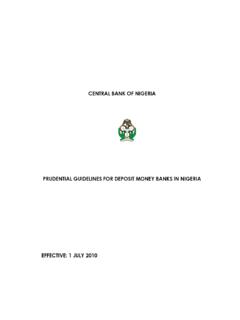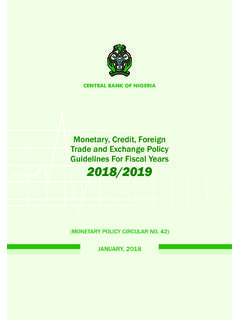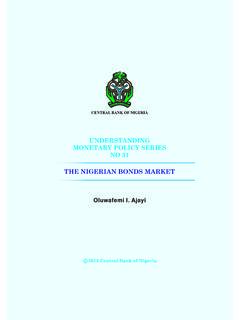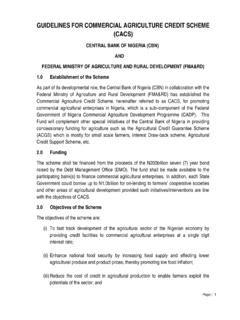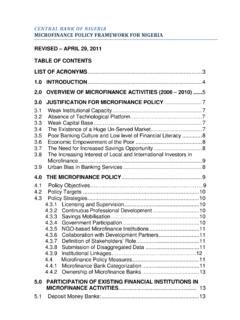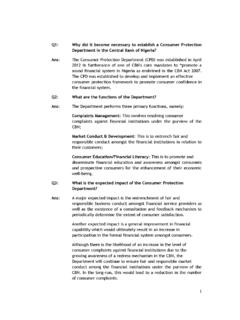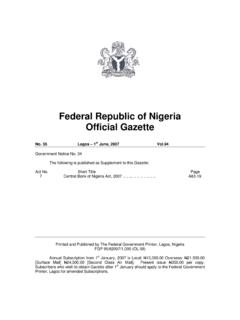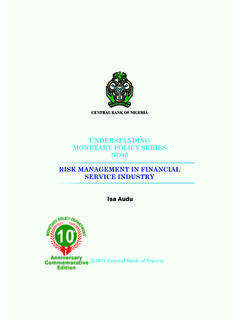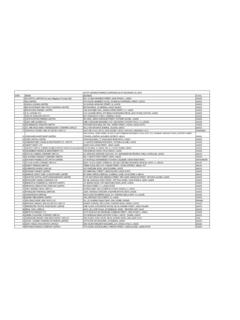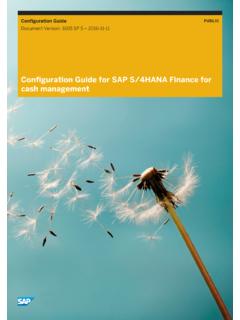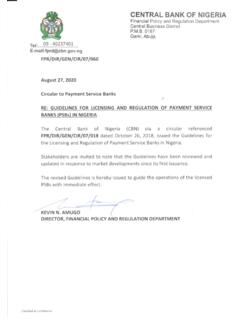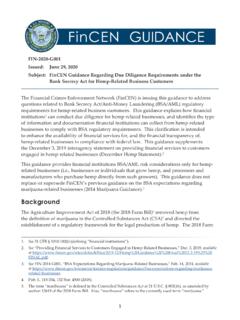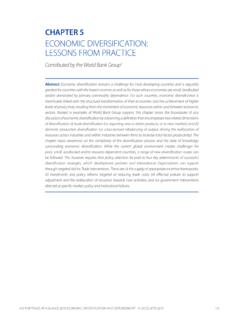Transcription of CENTRAL BANK OF NIGERIA
1 CENTRAL bank OF NIGERIA . PRUDENTIAL GUIDELINES FOR DEPOSIT MONEY BANKS IN NIGERIA . AUGUST 2019. CONTENTS. Introduction 5. Definitions 6. Risk Management 7. Credit risk 7. Limit on exposure to a single obligor/ connected lending 7. Credit concentration policy 7. Exposures to directors and their related interests 9. Disclosure of insider-related credits in financial statement 9. Bankers Acceptances and Commercial Papers 9. Basic Information on Borrowers and Minimum contents of credit files 10. Minimum information on credit print-outs 11. Margin lending 11. Revaluation of fixed assets 12. Foreign Exchange Risk 12. Liquidity ratios 12. Statutory reserve 13. Cash reserve ratio 13. Dividend pay-out 13. Capital adequacy ratio 14. Credit rating of counter party/ obligor 14. Credit rating of banks 14. Reconciliation of inter-branch accounts and settlement of 15. suspense account entries Foreign currency loans 25. Policies and procedures for write-off of fully provided credit 16.
2 Facilities 2. Misreporting 16. Lending to Customers 16. Margin loans 16. Management of Market Risk Corporate Governance 17. Tenured positions 17. Cooling off period 17. Know Your Customer and Anti-money laundering 18. 18. Know your customer 18. Anti-money laundering measures 18. Record retention 18. Correspondent banking Suspicious transactions 19. Loan Loss Provisioning 20. Credit portfolio classification system for facilities other than 20. Specialized loans . Provision for facilities other than Specialized loans as defined by 22. the guidelines Credit portfolio classification system for Specialized loans 23. Provision for Specialized loans 26. Collateral Adjustment for Lost Facilities 27. Treatment of IFRS Impairment Charge for Prudential Purposes 29. Credit Portfolio Disclosure Requirement 29. Disclosure Requirement for Specialized loans 29. Interest accruals 30. Classification and Provisioning for Other Assets 30. 3. Revolving and Overdraft Facilities 31.
3 Facilities Without Approval 33. Off- Balance Sheet Engagements 33. Regulators' power over adequacy of provisioning 33. NPL Limit 34. Financial soundness indicators and financial ratios 34. Update of the Prudential Guidelines 34. Effective date 34. Annexure 1 36. Annexure 2 38. Annexure 3 42. List of Acronyms 44. 4. INTRODUCTION. The CENTRAL bank of NIGERIA (CBN), in May 2010 issued the revised Prudential Guidelines (PG) to Deposit Money banks in NIGERIA . The guidelines, which replaced the Prudential Guidelines for Licensed Banks issued on 7th November 1990 was issued to correct the fragile financial system that was tipped into crisis by the global financial meltdown. Since the extant guideline was issued in 2010, the Nigerian banking landscape has experienced drastic changes caused by a range of issues, including the crises in the foreign exchange (FX) market, liquidity challenges, high incidence of non-performing loans (NPLs), poor corporate governance, increasing competition among banks fueled by cutting edge technologies, new approaches adopted by global standard setters (such as Basel Committee for Banking Supervision (BCBS) and International Accounting Standard Board (IASB)), among others The increasing importance of prudential regulation, combined with the factors earlier noted necessitated a review of the extant PG in order to address current realities.
4 5. DEFINITIONS. a) Margin loan is a loan that allows the customer to finance against shares. The term margin refers to the difference between the market value of the shares and the cost of shares. The primary and secondary sources of repayment are from the sale of the securities purchased. b) BVN means bank Verification Number. c) FGN Bonds are bonds issued by the Federal Government of NIGERIA , including SUKUK. d) Non-resident individual is an individual that was resident outside NIGERIA for more than 180 days in the preceding year. e) TIN means Tax Identification Number 6. RISK MANAGEMENT. At the minimum banks shall have comprehensive risk management policies for Credit, Market, Liquidity and Operational (including Cyber). risks as well as verifiable records/logs of occurrences of such risks. Credit Risk Credit policy to be duly approved by board of directors: Banks shall prepare a comprehensive credit policy duly approved by their Board of Directors. The policy shall, inter alia cover loan administration, disbursement and appropriate monitoring mechanism etc.
5 The policy shall be reviewed at least every three years. Limit on exposure to a single obligor/ connected lending: (a) The total outstanding exposure by a bank to any single person or a group of related borrowers shall not at any point in time exceeds 20 per cent of the bank 's shareholders fund unimpaired by losses. (b) 50 per cent of a bank 's off-balance sheet engagements shall be applied in determining the bank 's statutory limit to a single obligor as per (a) above. (c) The total outstanding exposure (on and off-balance sheet) by a bank to all tiers of government and their agencies shall not at any point in time exceed 10% of the total credit portfolio. (d) A large exposure is any credit to a customer or a group of related borrowers that is at least 10% of a bank 's shareholders fund unimpaired by losses. (e) Aggregate large exposures in any bank shall not exceed eight times the shareholders fund unimpaired by losses. Credit Concentration Policy: (a) Banks shall put in place effective internal policies, systems and controls to identify, measure, monitor, and control their credit risk concentrations .
6 The policies shall be approved by the Board of Directors and shall cover the different forms of credit risk concentrations to which a bank may be exposed. Such concentrations include: (i) Significant exposures to an individual counterparty or group of related counterparties;. (ii) Credit exposures to counterparties in the same economic sector or geographic region;. (iii) Credit exposures to counterparties whose financial performance is dependent on the same activity or commodity;. and 7. (iv)Indirect credit exposures arising from a bank 's Credit Risk Mitigation (CRM) activities ( exposure to a single collateral type or to credit protection provided by a single counterparty). (b) A bank 's framework for managing credit risk concentrations shall be clearly documented and shall include a definition of the credit risk concentrations relevant to the bank and how these concentrations and their corresponding limits are calculated. Limits shall be defined in relation to a bank 's capital, total assets or, where adequate measures exist, its overall risk level.
7 (c) A bank 's management shall, at a minimum, conduct quarterly stress tests of its major credit risk concentrations in line with the extant Guidelines on Stress Testing for Nigerian Banks and review the results of those tests to identify and respond to potential changes in market conditions that could adversely impact the bank 's performance. (d) Except for FGN bonds, supranational bonds, and corporate bonds that are quoted and marked to market, all other bonds shall be considered as credits in determining credit concentration. (e) All banks shall put in place policies on Credit Portfolio Plan as part of their credit risk management, which shall be approved by their respective boards. The plan shall specify the target portfolio size as well as portfolio distribution by industry, economic sectors, Business Units etc. The portfolio plan shall at a minimum consider the following: (i) Macro-economic climate including fiscal and monetary policy guidelines (ii) bank policies on its target market (iii) Minimum risk acceptance criteria definition for each bank (iv) bank 's policy on concentration risks by industry, market sector, and obligor (v) Historical portfolio and experience of each bank , etc.
8 (f) In defining the portfolio concentration limits for sectors, banks shall adopt the standard industry classification (SIC) of Economic Sectors issued by the CBN from time to time. (g) Where exposure to a particular sector (as defined by the Standard Industry Classification of Economic Sectors as issued by the CBN is in excess of 30 per cent of total credit facilities of a bank , the risk weight of the entire portfolio in that sector shall be 150 per cent. (h) Banks shall review their credit portfolio plan on a quarterly basis to ensure that the plan remains reflective of current market circumstances. In the event of material adverse changes affecting the macro-economic environment or particular sectors, industries or regions, appropriate review and mitigation strategies shall be performed 8. (i) In assessing credit risk concentration of a bank , the CBN will consider the credit concentration policy, the credit portfolio plan and the extent to which the bank considers credit concentration as part of the subjective factors in making specific provisions.)
9 Non- compliance with a bank 's established policy on credit concentration and monitoring shall form a basis for supervisory action which may include additional loan loss provisions under sections (e) (1) (ii); (e) (2) (ii) and (e) (3) (ii). The subjective factors shall also be extended to provisions on specialized loans. Exposures to Directors and their related interests: (a) A significant shareholding is defined as a holding of at least 5%. (individually or in aggregate) of a bank 's equity. (b) Director, insider and significant shareholder credit exposure shall be fully disclosed by banks in their financial statements and returns prescribed by the CENTRAL bank of NIGERIA . (c) Insiders include directors, significant shareholders, employees and investee companies (such as associates, subsidiaries, joint ventures) of banks, and other entities in which they have significant control. In line with the BOFIA, the term director includes director's wife, husband, father, mother, brother, sister, son, daughter and their spouses.
10 (d) Banks shall ensure that their credit policies specifically address lending to directors as part of related parties or insiders lending policies. (e) The limit on credit facilities to insiders and their related parties shall be as prescribed below: i. A director or a significant shareholder shall not borrow more than 1 per cent of shareholders' funds unimpaired by losses. ii. The aggregate credit facilities to all insiders and their related parties shall not exceed 10 per cent of shareholders' funds. Disclosure of Insider-related credits in financial statements: (a) Insider-related credits include credit facilities to shareholders, employees, directors and their related interests. (b) The disclosure required to be presented in the financial statements is as follows: iii. The aggregate amount of insider-related loans, advances and leases outstanding as at the financial year end shall be separately stated in a note to the accounts and the non- performing component further analyzed by security, maturity, performance, provision, interest-in suspense and name of borrowers.
